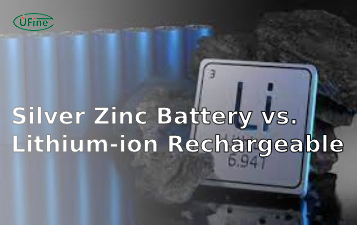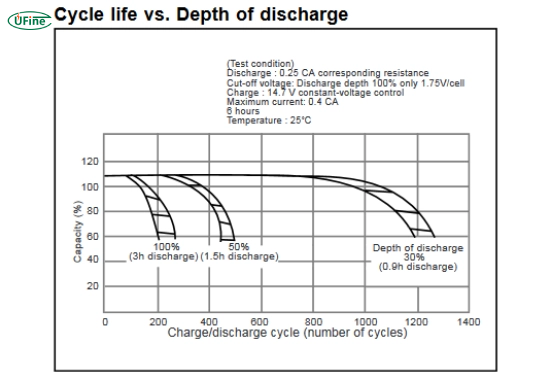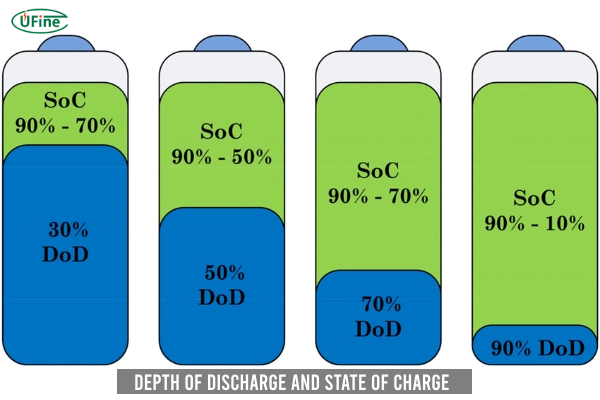
- Part 1. Understanding depth of discharge (DoD)
- Part 2. What happens during deep discharge?
- Part 3. Types of batteries that can handle deep discharge
- Part 4. What is the difference between depth of discharge and state of charge?
- Part 5. Benefits of deep discharge capabilities
- Part 6. The Importance of battery management systems
- Part 7. How to protect against deep discharge?
- Part 8. Common applications for deep discharge batteries
- Part 9. FAQs about battery deep discharge
Deep discharge refers to discharging a battery significantly, often to the point where it utilizes 80% or more of its capacity. It is crucial to understand how deep-cycle batteries function and how to maintain them for optimal performance. In this article, we will explore the intricacies of deep discharge, its implications for battery life and performance, and the various types of batteries that can handle deep discharges effectively.
What is Deep Discharge?
Deep discharge occurs when 80% or more of a battery’s total capacity is used before recharging. Unlike partial discharges (e.g. 30-50% DoD), this extreme depletion causes irreversible chemical changes:
- ✅ Lead-acid batteries: Sulfation crystal buildup
- ⚠️ Li-ion batteries: Lithium plating & SEI layer damage
- 🔥 All batteries: 40% faster capacity loss (per IEEE data)
Part 1. Understanding depth of discharge (DoD)
Depth of Discharge (DoD) describes the percentage of a battery’s capacity that a user has discharged relative to its total capacity. For instance, if a battery has a total capacity of 100 amp-hours (Ah) and the user has used 80 Ah, the DoD is 80%. This metric is essential because it directly impacts the lifespan and efficiency of rechargeable batteries.
- DoD Calculation: The formula for calculating DoD is straightforward. You can express it as follows:
DoD = (Capacity Used / Total Capacity) × 100%
A higher DoD indicates that more energy has been extracted from the battery. If not appropriately managed, this can lead to faster degradation.
Batteries frequently subjected to high DoD levels may not last as long as those kept within safer discharge limits. For example, you consistently use 80% of your battery’s capacity before recharging.
In that case, you may find that its overall lifespan decreases compared to a battery that discharges only 50% before being recharged.
Part 2. What happens during deep discharge?
When a battery undergoes deep discharge, several critical changes occur:
- Voltage Drop: As the battery discharges, its voltage decreases. Each battery type has a specific cut-off voltage where it ceases to function effectively. For example, lead-acid batteries typically should be discharged at 10.5 volts.
- Increased Internal Resistance: Deep discharging can increase the battery’s internal resistance. This makes it more challenging to recharge effectively and can lead to overheating during charging.
- Potential Damage: If discharged too profoundly, particularly in non-deep-cycle batteries, irreversible damage can occur. This may include sulfation in lead-acid batteries or lithium plating in lithium-ion batteries. Sulfation occurs when lead sulfate crystals form on the battery plates during discharge and do not dissolve into the electrolyte during charging.
- 58% in flooded lead-acid (300 vs 700 cycles at 50% DoD)
- 42% in standard Li-ion (800 vs 1,400 cycles at 50% DoD)
Part 3. Types of batteries that can handle deep discharge
Not all batteries function well in deep discharge applications. Here are the primary types that can manage this process effectively:
- Deep-cycle batteries: These batteries are designed to be regularly discharged to significant depths. They are commonly used in solar energy systems, electric vehicles, and marine applications.
- Lithium-ion Batteries: Due to their advanced chemistry and design, lithium-ion batteries can handle deep discharges better than traditional lead-acid batteries. They also have a higher energy density, meaning they can store more energy in a smaller space.
- Absorbent Glass Mat (AGM) Batteries: A subtype of lead-acid batteries that can tolerate deep discharges requiring less maintenance. AGM batteries are sealed and do not require water replenishment like traditional flooded lead-acid batteries.
| Battery Type | Max Safe DoD | Cycle Life at 80% DoD |
|---|---|---|
| Flooded Lead-Acid | 50% | 300-500 cycles |
| AGM | 80% | 600-800 cycles |
| LiFePO4 | 90%+ | >3000 cycles |
Part 4. What is the difference between depth of discharge and state of charge?
Understanding the Depth of Discharge (DoD) and State of Charge (SoC) is essential for effective battery management.
- Depth of Discharge (DoD) measures the energy a battery has used. For example, if you have a fully charged battery rated at 100 Ah and used 40 Ah, your DoD is 40%.
- The state of Charge (SoC) indicates how much energy remains available in the battery at any given time. Using the previous example, if you have used 40 Ah from your fully charged 100 Ah battery, your SoC would be 60%.
In summary:
- DoD focuses on how much energy has been consumed.
- SoC focuses on how much energy is left.
Both metrics are crucial for maintaining battery health and ensuring efficient usage.
Part 5. Benefits of deep discharge capabilities
Batteries designed for deep discharge offer several advantages:
- Extended Usage Time: They provide sustained power over longer periods, making them ideal for off-grid applications with limited recharging options.
- Cost Efficiency: While they may have a higher upfront cost, their ability to cycle deeply means they can be more economical over time due to reduced replacement frequency.
- Versatility: You can use deep-cycle batteries in various applications, from recreational vehicles (RVs) to renewable energy systems.
Part 6. The Importance of battery management systems
To maximize the lifespan and performance of batteries subjected to deep discharge cycles, implementing a Battery Management System (BMS) is crucial. A BMS helps monitor:
- State of Charge (SoC): This indicates how much charge remains in the battery.
- Temperature Control: Overheating during charging or discharging can damage the battery.
- Discharge Limits: Preventing deep discharges beyond recommended levels protects the battery from potential damage.
A BMS allows users to track their battery’s health and performance quickly. It alerts us when it’s time to recharge or if any issues need addressing.
Part 7. How to protect against deep discharge?
To safeguard your batteries from the adverse effects of deep discharge:
- Set Discharge Limits: Use devices or systems that automatically cut off power when a specific DoD is reached. This prevents over-discharging, which can cause damage.
- Regular Maintenance: For flooded lead-acid batteries, ensure proper water levels and clean terminals regularly to maintain good conductivity.
- Monitor Performance: Monitor voltage levels during use and recharge promptly when necessary. Voltmeters or smart chargers can help you track this information efficiently.
How to repair deep-discharged batteries?
- Lead-acid recovery: Use desulfation chargers (e.g. NOCO Genius) at 2.4V/cell for 48 hours
- Li-ion emergency: If voltage drops below 2.5V/cell, slow-charge at 0.05C to 3.0V first
- Success rate: AGM batteries have 70% recovery chance vs 30% for flooded (per Battery University tests)
Recommended Deep Discharge Protection Tools
- Victron BMV-712: Bluetooth battery monitor with DoD alarms
- NOCO Genius GenPro 10: Recovery charger for sulfated batteries
- Renogy 500A Battery Monitor: Shunt-based SoC tracking
Part 8. Common applications for deep discharge batteries
Deep discharge batteries are widely used across various sectors:
- Renewable Energy Systems: Solar energy storage requires batteries that can handle frequent deep discharges without significant degradation over time.
- Electric Vehicles (EVs): EVs rely on deep-cycle capabilities for extended driving ranges between charges, allowing drivers to travel longer distances without needing frequent recharges.
- Marine Applications: Boats often utilize deep-cycle batteries because they can withstand repeated discharges and provide reliable power for onboard systems like lights and navigation equipment.
Part 9. FAQs about battery deep discharge
What exactly is deep discharge?
Deep discharge occurs when 80% or more of a battery’s total capacity is used before recharging. This extreme depletion causes irreversible chemical damage in most battery types.
Can all batteries handle deep discharge?
No. Only deep-cycle batteries (AGM, Gel, LiFePO4) can safely handle 80-100% discharge. Standard lead-acid batteries risk permanent damage at over 50% depth of discharge.
How does deep discharge shorten battery life?
Repeated deep cycling accelerates wear 3-5x faster. Lead-acid batteries develop sulfation crystals, while lithium-ion batteries experience lithium plating and SEI layer degradation, reducing total cycle life by 40-60%.
What precautions protect against deep discharge damage?
- Install battery management systems (BMS) with voltage cutoffs
- Maintain discharge depth below 50% for lead-acid, 80% for lithium
- Use smart chargers with desulfation modes monthly
- Monitor state-of-charge with battery monitors
What are the signs of deep discharge damage?
- 30%+ reduced runtime
- Swollen battery casing
- Voltage drops below 10.5V (12V system) under load
- Overheating during charging
- Failure to hold a full charge
Can a deeply discharged battery be recovered?
Yes, if voltage hasn’t dropped below critical levels (10.5V for 12V lead-acid, 2.5V/cell for Li-ion), use specialized chargers like NOCO Genius in recovery mode. AGM batteries have 70% recovery success vs. 30% for flooded lead-acid.
Related Tags:
More Articles

What is the Difference Between Silver Zinc Battery vs. Lithium-ion Rechargeable?
Compare silver zinc and lithium-ion rechargeable batteries: energy density, cycle life, safety, cost, and uses in drones, medical devices, EVs, and electronics.
What are Watts and Watt Hours in Battery?
Understand watt vs watt-hour in batteries: key differences, how to calculate capacity, and why they matter. Includes free comparison table.
Best 10 Blood Pressure Monitor Battery Review: Finding the Most Reliable
Are you looking for a reliable Blood Pressure Monitor battery? Here is a complete guide with the top 10 best blood pressure monitor batteries.
Bluetooth Headphone Battery Guide: All You Need to Know
Maximize headphone battery life with expert tips! Learn how to charge, check, troubleshoot, and choose the best bluetooth headphone battery in 2025.
LiFePO4 Battery VS. Lithium-ion Polymer Battery: Which One Is Best?
Comprehensive comparison of LiFePO4 vs Lithium Ion Polymer batteries: energy density, safety, lifespan, cost. Find out which battery suits your needs in 2025.




